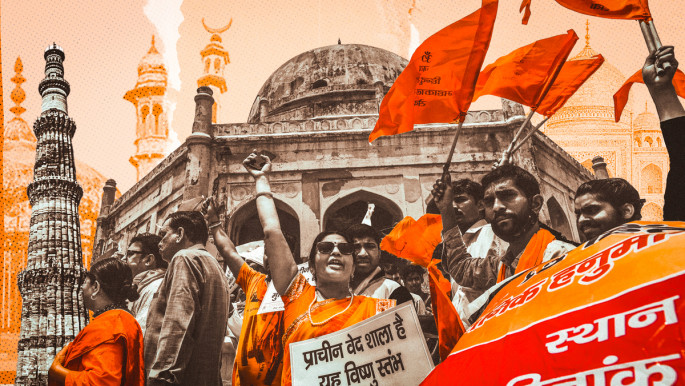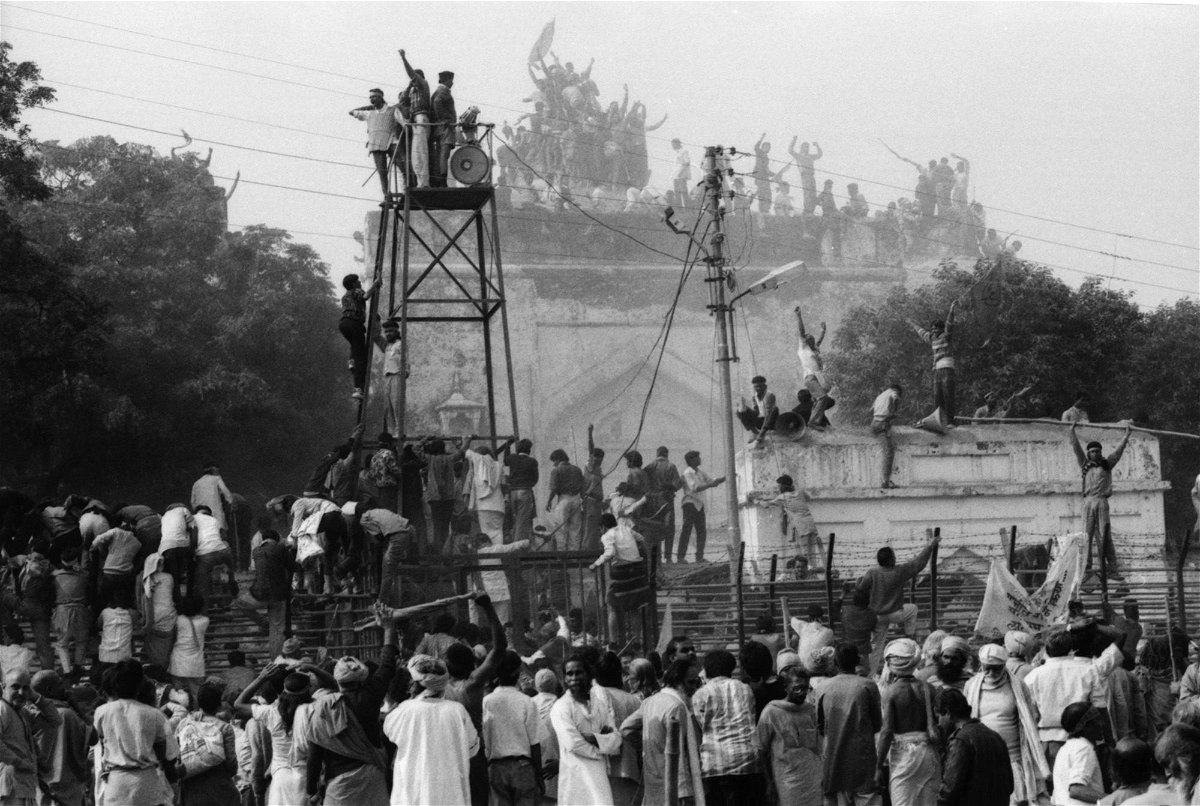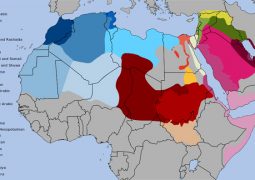How Hindu nationalism is threatening to erase India’s history of coexistence

In 1992, a mob of Hindu extremists, including senior members of the BJP, destroyed the Babri Masjid, a nearly 500-year-old mosque in Ayodhya
Millions of visitors each year visit the famous Taj Mahal, the gleaming white tomb that is the eternal symbol of love. Built by the Mughal king Shah Jahan as a mausoleum for his wife, it is regarded as one of the world’s most stunning buildings, a pinnacle of Islamic architecture, and India’s best-known landmark.

Many, however, are challenging this time-worn story with falsehoods and misinformation. They have twisted its history into one of ‘Muslim domination’, claiming – without evidence – that the Taj Mahal was in fact a Hindu temple, and that a Muslim king built his own structure atop to assert Islamic supremacy.
“To Hindu nationalists, Indian history is essentially black and white; that Muslims were invaders who destroyed the country, and Hindus and their religion were the victims”
This sort of pseudo-history is becoming more and more familiar in India.

Increasingly, India’s heritage is being dragged through the mud by India’s Hindu nationalists, led by Prime Minister Narendra Modi and his Bharatiya Janata Party (BJP), and has become a key battleground between Hindu nationalists and secular Indians.
Hindu nationalism is a majoritarian worldview based on Hindu supremacist ideology that is against India’s secular principles and defines the country as a ‘Hindu homeland,’ not too unlike Zionist claims about the state of Israel. Everyone else – including and especially Muslims – are outsiders. This once-fringe worldview has become the dominant ideology today.
Proponents of this ideology have attacked India’s diverse history, claiming that all Muslims were invaders who destroyed indigenous culture and religions and subjugated Hindus for hundreds of years.
Viewed in that light, every monument built by a Muslim dynasty – and there are many of those, as Muslim kings ruled parts of India on and off for the past 800 years – is suspected of being built on a Hindu site.
A combination of conspiracy theories, misleading claims and complete fabrications are peddled as historical certainties by Hindu nationalists in India. To Hindu nationalists, Indian history is essentially black and white; that Muslims were invaders who destroyed the country, and Hindus and their religion were the victims.
In reality, the past is intricate and complex, woven together through the stories of different peoples, languages, and religions, and is far from the black and white portrayal presented by Hindu nationalists.

Hindu nationalism and history
Indian history, like any history, is filled with nuances. Modern religious divides that have been thrust upon the population did not exist in the same way in the past, but Hindu nationalists in today’s India appear insistent on erasing centuries of history, architecture, culture and advancement made under Muslim and secular rulers.
“All that these guys rely upon are stories – the same stories where they say that for hundreds of years, all Muslims have done is broken temples,” says Yunus Lasania, a journalist and oral historian who organises heritage walks around Hyderabad in India.
“They don’t want to accept that India’s confluence of cultures exists. It’s very conveniently erasing history to fit their narrative. And the damage will last for a very, very long time.”
At its heart lies the overarching belief that ancient Indian Hindu civilizations were far more advanced in technological and societal terms than we think of them, in some ways far more advanced than we are today. They claim that Hindus controlled a massive chunk of land called Akhand Bharat or Greater India, which is believed to include Afghanistan, Pakistan, India, Nepal, Bangladesh, and parts of southeast Asia as part of this dominion.
All of those advancements were wiped out by marauding Muslim conquerors who came from abroad and dragged the people of this subcontinent back to the stone age, they claim, and the few Hindu rulers or kingdoms that managed to hold off the invaders deserve to be seen as heroes.
“They don’t want to accept that India’s confluence of cultures exists. It’s very conveniently erasing history to fit their narrative. And the damage will last for a very, very long time”
Like all pernicious misinformation, there is a kernel of truth within these claims that have been wrapped in layers of falsehoods and misconceptions.
The civilizations that grew in the Indian subcontinent were indeed surprisingly advanced. Right from the ancient cities of Harappa and Mohenjo-Daro, known for their urban planning during the Bronze Age, to the cultures built by the Mauryas, the Guptas, and later on the kings of Vijayanagar, Hindu kingdoms played an essential role in advancing the knowledge of mathematics and the sciences and attracted merchants, scholars, and travellers from around the globe.
The falsehood, however, is that Muslims arrived and destroyed India’s Hindu legacy. In reality, the Muslims that arrived in India influenced and built upon the existing civilizations for the most part, and Islam in turn was hugely impacted by local traditions and beliefs.
“India’s Muslim history is rich; it’s not like you had ten Muslims who came and became barbarians,” says Lasania. “You have a history of around 800 years.”
The Hindu nationalist revision of history is having tangible, violent consequences on the ground. In 1992, a mob of Hindu extremists, including senior members of the BJP, destroyed the Babri Masjid, a nearly 500-year-old mosque in Ayodhya, Uttar Pradesh.
They claimed the mosque had been built on the site of the birthplace of the Hindu deity Lord Ram. Its destruction led to countrywide riots that killed more than 2000 people, mostly Muslims. In 2020, Prime Minister Narendra Modi laid the foundation for a new temple on that site.
“In 1992, a mob of Hindu extremists, including senior members of the BJP, destroyed the Babri Masjid, a nearly 500-year-old mosque in Ayodhya, Uttar Pradesh”
India’s history since Modi took power in 2014 has become even more up for debate, with accepted facts and archaeological evidence discounted for religious fervour.
the Gyanvapi mosque in Varanasi, Hinduism’s holiest city, as right-wing groups claim a fountain in the ablution pool of the mosque is actually a sacred Hindu object. The Shahi Eidgah in Mathura is also being targeted by these groups, who claim that the land it was built on belongs to the Hindu deity Lord Krishna.
These actions have come in spite of an Indian law called the Places of Worship (Special Provisions) Act, 1991 that prohibits the conversion of any place of worship from the way it existed on the day India gained Independence on 15 August 1947.
Now you can’t even pray in a mosque. We are seeing a full scale war against Muslims. https://t.co/w1rTVEu281
— Shivam Vij (@DilliDurAst) May 17, 2022
Hindu nationalists have created a pervading feeling of fear and violence among the minority communities, especially the Muslims, in India, and their attempts to alienate Muslims and reject their history are being increasingly and dangerously successful.
Muslims in India
Islam arrived in India from its heartland on the Arabian peninsula in a variety of ways. The religion first arrived along the western coast through traders in the 600s, through Sufi mystics who travelled through the region, and through conquest.
The Sufis played arguably the most important role in spreading Islam in the subcontinent, bringing their Islamic mysticism to India and making their religion incredibly accessible to the local population.
- Previous Modi hails verdict as top court desicion on destroyed by hindu nationalists 30 years ago Ayodhya masjid
- Next Oil prices to rise after Houthi attacks in the Red Sea shipping












